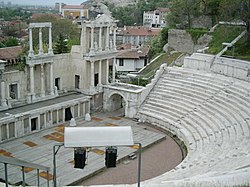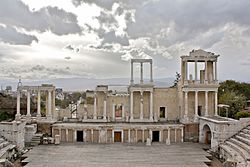 | |
| Location | Plovdiv, Bulgaria |
|---|---|
| Coordinates | 42°08′56″N24°45′21″E / 42.148811°N 24.755862°E |
| Type | Gate |
| History | |
| Builder | Hadrian |
| Founded | 2-4th century AD |
| Periods | Antiquity |
| Site notes | |
| Excavation dates | 1970s |
The Eastern gate of Philippopolis is one of the three entrances of the ancient city that have been discovered in Plovdiv. The gate was built on the main road to Byzantium and the Bosphorus. Initially constructed in the 2nd century AD during the reign of Hadrian, the gate and the complex around it were completely rebuilt in the 4th century, and partially repaired in the 5th century. The Eastern gate was discovered in the 1970s.

















